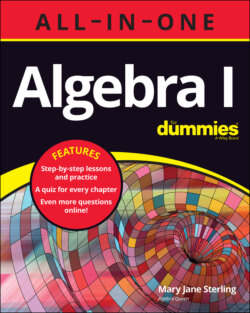Читать книгу Algebra I All-in-One For Dummies - Mary Jane Sterling, Mary Sterling Jane - Страница 38
Using the number line
ОглавлениеWhen comparing negative numbers, the number closer to 0 is the bigger or greater number. You may think that recognizing that 16 is bigger than 10 is an easy concept. But what about –1.6 and –1.04? Which of these numbers is bigger?
The easiest way to compare numbers and to tell which is bigger or has a greater value is to find each number’s position on the number line. The number line goes from negatives on the left to positives on the right (see Figure 2-1). Whichever number is farther to the right has the greater value, meaning it’s bigger.
FIGURE 2-1: A number line.
Q. Using the number line in Figure 2-1, determine which is larger, –16 or –10.
A. The number –10 is to the right of –16, so it’s the bigger of the two numbers.
Q. Which is larger, –1.6 or –1.04?
A. The number –1.04 is to the right of –1.6, so it’s larger. A nice way to compare decimals is to write them with the same number of decimal places. So rewrite –1.6 as –1.60; it’s easier to compare to –1.04 in this format.
Now that you’ve seen some examples of using a number line to compare numbers, try the following problems for practice. Use the number line found in Figure 2-2.
FIGURE 2-2: Another number line.
1 Which number is larger, 4.6 or ?
2 Which number is larger, or 0?
3 Which number is larger, or ?
4 Put the numbers in order from smallest to largest: 4, 0, , .
5 Put the numbers in order from smallest to largest: .
